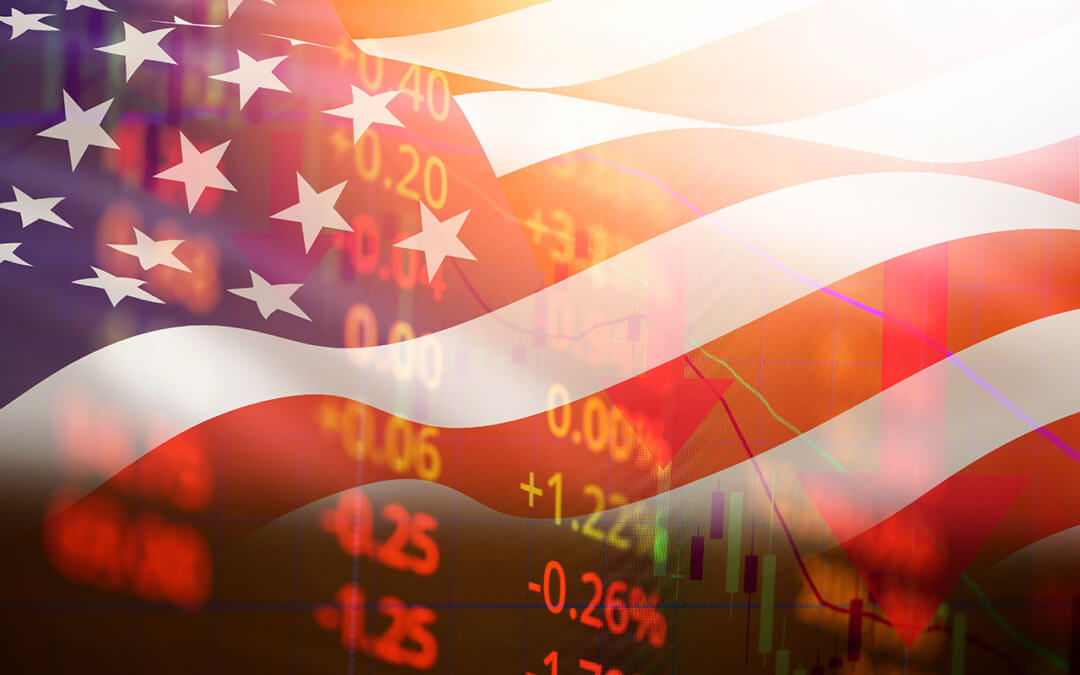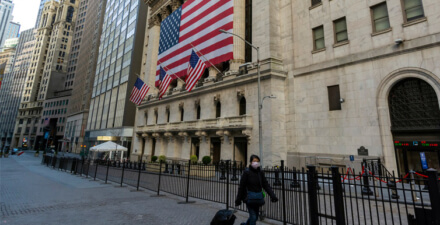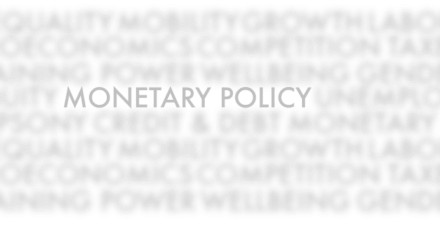The hidden costs of stock-market-first U.S. economic policies

The idea that sound U.S. economic policy begins and ends with a strong stock market is becoming pervasive. Advocates of what I call the stock-market-first approach want you to focus on the stock market when you pass judgment at the ballot box this November. Stock market indexes are back to pre-coronavirus pandemic levels and, until recently, were testing new highs. If you have a 401(k) savings plan, it probably soared over the past 4 years.
The dramatic jump in the stock market since the 2016 election is the only information that a true believer in stock-market-first thinks you need to know. There is no need for you to understand why the stock market has gone up. There is no need for you to understand how the policies that increased stock prices came at the expense of other things you also might care about.
But if you are planning to vote with your 401(k) in mind this November, then you might want to take the time to understand the why and the how of the recent stock market boom.
Stock prices are determined by three factors. The first is the profits that companies are expected to earn. The second is the safe rate of return on government debt set by the Federal Reserve. And the third is the risk premium that stock investors earn on top of the interest they would get if they held government debt instead.
Once you understand how movements in profits, interest rates, and risk premia together affect the stock market, it is a short jump to understanding the role of government policy. Nothing new has been discovered in recent years about how government policies affect stock prices. We have just reached the point of pushing policies that inflate the stock market without regard for the consequences.
Once you understand that government can move the stock market, you are entitled to ask whether and how government should move the stock market. If government policy creates imbalances between economic fundamentals and stock prices, those imbalances are revealed in time, and often with disastrous consequences, especially for 401(k) investors who are largely invested on autopilot.
And even if government takes extraordinary additional steps to avert the collapse of an overvalued stock market, the policy actions needed to keep stock prices inflated impose other costs. When government moves income, wealth, and debt around to boost stock prices, that money must come from somewhere. Your 401(k) account may have gone up, but the things you lost along the way are likely larger than the gains.
Think about your slow salary growth and low interest rates on your savings accounts. Think about funding for the programs such as Medicare and Social Security that you also will depend on. Or, even more broadly, think about the importance of sustained economic growth to you and your family, compared to a boom-and-bust economy characterized by soaring stock prices followed by swift and sometimes-deep recessions.
If you are content not knowing how government policy helped fuel the recent stock market boom and what that means for your future, you should stop reading. But if you would like to know a little more about the hidden costs of stock-market-first economic policies, you might want to read on.
What moves the stock market?
Business schools teach you that a share of corporate stock just represents the value of the legal claim today on expected future company profits. The value of the stock is simply that stream of future profits converted to a present value.
If I promised to pay you $10 per year for the next 10 years, what is that worth to you today? If you place no value on time (and ignore inflation), the answer is just the $100 total you will receive over the 10 years.
But if time does have value to you—meaning $10 today is worth more than $10 next year, and so on—the present value of the 10 $10 payments is less than $100. In fact, if you value time at (say) 2 percent per year, then business schools teach you that the stream of promised $10 payments for the next 10 years is worth just less than $90.
If you prefer to think in forward-looking terms, this present-value calculation is the same as saying, “If you put $90 in the bank today at 2 percent interest, at the end of the 10 years, you would have $100.”
Pretty basic math.
Stocks are more complicated because the future company profits are not a promise of certain payments; they are expectations about unknown payments. Analysts working on Wall Street make good money by predicting future profits, but there is uncertainty around even the best predictions.
Introducing uncertainty means the calculation of a stock’s value needs one more input. In addition to valuing time, you need to value the uncertainty about the profits. If the government will pay you 2 percent interest with certainty, why would you buy a stock that paid an expected 2 percent return, knowing you could lose money if the company’s profits are below expectations?
So, assume that instead of a 2 percent interest rate, the rate of return on the stock is expected to be 5 percent. That is, by switching from the guaranteed government interest rate of 2 percent to the stock, you will receive, on average, a 3 percent “risk premium” on the investment. Sticking with the $10 payment per year over 10 years, but using a discount rate of 5 percent, the stream of payments has a present value today of about $77.
Again, in forward-looking terms, that means investing $77 in the stock market today is expected to leave you with $100 in 10 years. But the only thing you really know is that the actual amount in 10 years will be centered around an expected $100, and it could be a lower or higher. That is what uncertainty means.
And remember, if you want to be sure you will have $100 in 10 years, you should invest $90 in the 2 percent government bond. That is, you can just pay $13 more now to avoid the uncertainty about having exactly $100 10 years from now.
These examples are intentionally simple, but they make it possible to introduce a key point about how stock prices move. When one of the pricing inputs changes, the effect on stock prices is magnified. So, if the profits of a company are expected to grow 1 percent per year for the 10 years instead of staying constant at $10, the stock price jumps 5 percent, to $81. In the real world, where companies earn profits for more than 10 years, this magnification effect is obviously much larger.
The same amplification principle holds for changes in the real interest rate on government debt and the risk premium. If the interest rate on government debt is decreased from 2 percent to 1 percent, then the present value of the 10-year stream of $10 payments is worth $81, a 5 percent increase in the stock price.
If the world becomes more uncertain, such that the risk premium jumps from 3 percent to 6 percent, then the stock price falls from $77 to $67. Small changes in stock-price determinants lead to big changes in stock prices.
Lest you think this is all that I think you need to know in order to make money in the stock market, remember that the relatively simple math just tells us what a share of stock should be worth. Expectations about future profits and the risk premium move with market participant beliefs. The stock you own is only worth exactly what the highest bidder is willing to pay for it.
In 2013, the Nobel Memorial Prize in Economic Sciences was split three ways. Each of the recipients had made significant contributions in the field of “asset pricing,” which basically means thinking about what a share of stock should be worth. The fact that the prize was split between three economists with different views about what people believe and how they act is suggestive that the puzzle of valuing the stock market is far from solved.
Nobel Prizes are not given out for casual observation, but luckily, the details about “price earnings ratios” and “method of moments” and “three factor models” are not key to the message here. What matters is that the three key stock-price determinants—expected profits, interest rates, and risk premia—move together and reinforce each other.
The ways in which the three stock-price determinants move together is well-established. If the Fed lowers the risk-free interest rate or something happens to make investors think profits will increase, then the price goes up. If investors become more confident about a given profit prediction, then stock prices will rise further. When stock prices go up, there is a reinforcing effect on investor confidence, and stocks move up even more.
The existence of these positive feedback loops means stock prices move in waves. Stock market booms are generally slow and long-lasting, as the reinforcing effects of higher expected profits and confidence build on each other gradually.
Stock market busts are generally shorter-lasting but more intense because the truth about profits and risks are often revealed very suddenly. Investors know that maintaining optimistic beliefs while everyone else becomes pessimistic means they will be left holding stocks that others value less.
At the end of the day, the stock market is necessarily tied to economic fundamentals. The value of a stock is the expected value of the company’s profits, discounted at some interest rate that includes a risk premium. Humans can make systematic mistakes about future profits and risk premia, but ultimately, those mistakes will be revealed.
How does government move the stock market?
The stock-price math taught in business schools tells us that the value of a stock boils down to the risk-free rate of interest you can earn on government debt, the company’s expected profits, and the current risk premium added to the risk-free interest rate.
So, how can government move the stock market? By choosing policies that move the three inputs. Start with the Federal Reserve. The Fed controls short-term, risk-free interest rates directly. In times of financial crisis, the Fed also intervenes in other ways that impact expected profits and certainty.
One of the most poignant recent lessons about short-term interest rates and the stock market comes from 2018. In late summer of that year, Fed Chairman Jerome Powell began to signal the Fed’s intention to “normalize” interest rates, meaning allow rates (adjusted for inflation) to increase back toward historical averages. Powell said clearly that interest rates were well-below neutral in early October.
The stock market plunged between October and December of 2018, erasing most of the gains registered over the preceding 2 years.
In late 2018, Fed officials began to speak publicly about how they may have overstated the need for future interest rate increases. By December, the Fed had walked back plans for further planned increases. Finally, in 2019, the Fed began cutting rates. The stock market applauded the action, regained its losses, and grew in 2019—achieving new highs at the onset of the coronavirus pandemic in early 2020.
The Fed proved that it could boost the stock market and provide economic stimulus by keeping interest rates low. But this was not a newly discovered magic bullet. Fed officials got their jobs because they got good grades in the business and economics classes where the basic stock market math is taught.
Cutting interest rates, however, while the U.S. economy was still expanding in 2019 was an unusual policy move. Historically, the fear was that keeping interest rates too low for too long will lead to an overheated economy and inflation.
One possibility is that the noninflationary (or “equilibrium”) short-term interest rate has decreased in recent years. Historically, the Fed’s short-term interest rate target was maybe 2 percent or 3 percent, adjusted for inflation. Historically, keeping rates below that target for a prolonged period did lead to higher inflation.
The fact that inflation did not surge after the 2019 interest rate cuts suggests that the equilibrium interest rate the Fed should target has changed. Indeed, in a recent speech, Powell focused on how the lack of inflation is a key indicator that interest rates are not too low.
Economists believe that changes in the economy from a variety of factors—globalization, declining productivity, and the aging of the population—may have pushed the optimal short-term interest rate down. In this view, the Fed has just responded to the new economic environment and cut interest rates to keep the economy on track.
I will come back to this “new equilibrium interest rate” view of the stock market below, but first, we need to think about how other types of government policies also move the stock market.
In addition to what the Fed can do, the legislative and executive branches can affect stock prices directly through regulatory actions and tax policy, or indirectly through spending and deficit policies.
The easier plays—regulatory actions and tax policy that directly boost stock values—have been the clear choice of stock-market-first advocates. There are no great insights here, and one does not need an Ivy League business school degree to read the playbook on using such policies to increase stock prices:
- If we allow businesses to rely on cheaper, more environmentally destructive production techniques, then profits will go up.
- If we allow businesses to cut wages and benefits without regard for worker rights and well-being, then profits will go up.
- If we allow competition-destroying merger activity, then profits will go up (for the firms that survive) and overall industry profits will be higher.
- If we reduce taxes on corporate profits, then the profits available to pay out dividends to investors will go up.
The question is not whether these policies can increase profits and stock prices, at least temporarily. They can. But adopting these policies does raise two other questions.
The first question is whether regulatory and tax policies lead to a permanent increase in profit levels or, even better, to a higher growth rate for profits. If the effects on profits are temporary, then these actions are fueling a stock market bubble because profit expectations will rise and then fall.
And even if the increases in profits are permanent, we need to ask whether the higher profits represent an efficient reallocation of the nation’s resources. If we are just transferring more of our national wealth to business owners, then are you better-off? Your 401(k) investments may be increasing in value, but at the expense of what else that is important to your economic health and well-being?
Are we in a stock market bubble?
The first question we should ask about stock-market-first government policy actions is whether we are creating a stronger economy or just generating wild swings in the stock market. If policy is fueling booms and busts, then we may be at or near the top of one of those cycles.
Distinguishing short- and long-run movements in stock prices is easy in hindsight. Stock market bubbles are declared to have happened after the bubble bursts, not while the bubble is expanding. But what we can do, at a point in time, is to look at the relationship between stock prices and the underlying economy in which everyone operates.
The famed stock market value investor Warren Buffet has long advocated that we simply look at the ratio of overall stock market value to the size of the economy, and, by that measure, the stock market is grossly overvalued.
More technical valuation measures are based on the three principles above—government interest rates, expected profits, and the risk premium—but those more technical measures also indicate stock market values are at historical peaks.
In short, even if you believe that the policy-driven increase in profits will persist and you believe the Fed will keep rates low, then stocks still are at the top of their historical range. The imbalance between economic fundamentals and stock prices is already here.
It might be the case that there is a new stock market math at play, and it goes hand-in-hand with the new equilibrium interest rate view. Inflation is not rising, which suggests that the economy is not overheated, and stock prices simply reflect the new equilibrium interest rate.
The lack of inflation is a mystery to the Fed and economists generally, but that may be because we are looking for inflation as the product of a “demand-pull” effect. The idea of demand-pull in this context just means that higher stock market wealth increases demand for goods and services and that bids up prices in an otherwise fully employed economy.
We are indeed collectively spending more in recent years, and that has led to increased employment. But inflation is not budging. Why?
There is another way to look at inflation, known as the cost-push effect. The term cost-push was coined in the 1970s, when unions and oil prices seemed to “push” businesses to raise their output prices to remain profitable.
What may be happening in recent years is that cost-push inflation is working in reverse. Government undertakes regulatory and tax policies that lower costs for all businesses, and businesses do what they teach in business school—they compete on price.
If firms operating in the same competitive market all experience the same cost decrease, then they will eventually lower the prices of the goods and services they are selling to maintain their market shares. The only possible exception to the rule is industries where there is a lack of competition—industries where government has not enforced antitrust laws.
But in general, an economist looking at recent regulatory and tax policy changes might wonder why someone would have ever expected a long-run increase in profits. If every business in a specific market is forced to follow the same regulations and pay the same taxes, then the costs are mostly just passed forward to consumers. That process works in reverse as well. Cutting the same costs for all businesses means lower prices or, at least, less pressure on further price increases.
But the goods are not truly cheaper. We consumers just stopped paying for things such as environmental protection and decent wages and meaningful health benefits for the workers at those firms.
The lower interest rates needed to prop up the inflated stock market are also impacting retirees and those saving for retirement. If you have practiced good financial hygiene and kept some of your savings in fixed-interest bonds, then you are earning a lot less on that part of your portfolio.
There is no free lunch, but sometimes, the price is hidden.
If cost-push forces are really what is keeping inflation low in recent years, as seems likely, then the path to resolution of an overvalued stock market is through profits and the risk premium. When businesses compete away the reduced costs handed to them through regulatory and tax policies, the temporary boost in profits disappears.
And when the temporary boost to profits disappears, we are left staring at an overvalued stock market, with interest rates already close to zero, wondering when the bubble will burst. The only solutions are even more regulatory action or tax cuts and even lower interest rates.
If that sounds familiar, it is because you have been hearing about the need for more deregulation and lower taxes from stock-market-first advocates for decades. But lest you worry, the true believers in stock-market-first will tell you the next regulatory or tax fix is going to take care of everything, once and for all.
And yes—the stock-market-first agenda sounds more like a drug problem than good economic policy.
So, how should government move the stock market?
Even if stock-market-first policies do lead to some real economic growth, the follow-up questions we should ask are whether those policies are worth the cost and whether there is an alternative.
There are two ways that government policy can spur economic growth. The first is to engineer increases in stock prices using deregulation and corporate tax cuts, and we know that is possible. It even feels good on the way up. If we make stock owners wealthier, then they spend more, and the additional spending leads to increased employment and income for everyone else.
Giving up things such as environmental protections, decent wages, or a fair rate of return on risk-free retirement savings might just be the price of continued economic growth. But that higher growth does not mean you are personally better-off. You may reap some of the benefits of stock-market-first economics through a higher 401(k) balance, but you also pay the costs.
There is an alternative, but it requires understanding that although we can achieve the same or even better economic growth and employment, the nature of that growth will be different. The alternative would be more equitable, because we would not be relying on ever-increasing wealth inequality to grow the economy.
In addition to having regulatory and tax levers, government can grow an economy by investing or supporting investment in people, places, and things. Those sorts of investments can change one of the major underlying drivers of the “new” equilibrium interest rate environment by boosting productivity growth.
A slowdown in economic growth is not inevitable, but we need to realize that the types of investments we need to grow our economy are simply not seen as immediately profitable to people who already have a lot of money. If companies were already making these investments, then we would not be wondering why we are failing to grow an economy with so much obvious potential. Specifically:
- We need to invest in people so that more people are qualified to work at the jobs the rest of us truly value in a technologically evolving world.
- We need to invest in places, which means both in direct public infrastructure and in programs to direct loans away from big business and toward small businesses and private ownership of homes.
- We need to invest in things, especially technology. And we need to understand that much of the technology we see today began in universities and large public research organizations and, beyond that, often involves private and public partnerships.
- We need to cooperate in new ways on healthcare, retirement programs, and income security. Government created these sorts of cooperative programs because private markets failed to give us what we needed, and we should focus on making those programs better, not defunding and destroying them.
- We need to stop listening when some politicians say that taxes are a destructive force for innovation and growth. We need to hear instead that the income generated from a stronger and more productive economy is, in part, a return on our public investments, and failure to tax that income is the same as foregoing our collective rights to those investments.
Most importantly, we need to get past the fundamental principle espoused by stock-market-first advocates. They want you to believe that anything of value to the rest of us must involve people who already have a lot of money making even more money using that money.
Sound economic policies will boost the stock market because higher productivity means higher wages and higher profits. More importantly, the boost will be permanent and consistent with economic fundamentals. Low interest rates are not needed to prevent a stock market collapse.
Consider policies that did not exist when our oldest voters were born. Social Security, Medicare, Unemployment Insurance, the GI Bill, the national highway system, the Environmental Protection Agency, NASA, support for higher education, and research by the National Institutes of Health. Those policies made us better-off because we worked together, made investments, and reaped the rewards.
And acknowledge that every one of those policies was subject to the same screams about excessive government that stock-market-first advocates regularly employ. But voters chose not to listen. They knew better.
And policy today? The imagination of stock-market-first politicians has become limited to undoing the environmental and workplace safeguards we value and lowering taxes to boost profits and the stock market.
History and logic tell us that sort of game can indeed ratchet the stock market to new levels, but it does not change long-term growth rates. History and logic tell us there is a cost to supporting inflated stock prices. Just look most recently at the costs to our economy of the Great Recession of 2007–2009. Or the costs evident in our current pandemic economy.
The Fed is running out of levers to accommodate policy failures and prop up inflated stock values. Interest rates are already effectively zero, and the Fed is now relying on interventions that directly target the problems generated in the name of free market efficiency.
At the onset of the coronavirus pandemic and resulting recession, the Fed was forced to guarantee the excessive debt issued by corporations during the preceding stock market run-up. Much of that debt was issued by corporations to buy their own stock and further inflate stock prices during the boom.
Had the Fed not stepped in to guarantee corporate debt, the risk premium would have shot up because investors would rightly fear a surge in bankruptcies, stocks would have tanked, and the economy would have imploded.
Lowering interest rates and guaranteeing corporate debt was the right thing to do, given the situation the Fed was facing.
The point here is that the Fed should have never faced that situation. The situation was created by the disastrous regulatory and tax policies put in place before the pandemic. The situation stemmed from choices made by stock-market-first politicians. The situation was not inevitable.
And what about the future? Current stock prices are out of sync with economic fundamentals. But there is not a lot more the Fed can do, beyond buying corporate stock directly.
The pressure to reconcile even current stock values with future profits in our low-growth economy suggests that corporate owners will lobby to further increase their share of the pie, lest the imbalance between actual and expected profits be revealed.
The pressure from economic fundamentals means corporate owners will lobby for more ways to lower your wages and benefits. That means your Social Security and Medicare are less secure. That means your health insurance will cost you more. That means your safe retirement income will be even lower.
The costs to you of stock-market-first U.S. economic policies
Advocates of stock-market-first economic policies would have you focus on new stock market highs as proof they know what is best for the economy. Specifically:
- They want you to overlook the fact that they are using government to get an increasingly larger share of the economic pie for themselves.
- They want you to ignore that their policies are inhibiting overall growth in the very economic pie from which they are taking that bigger share.
- They want you to ignore that government-organized economic cooperation is often the key to real economic growth shared equitably between workers and business owners.
- They want you to ignore that the absence of worker bargaining power is gutting the middle class.
- They want you to ignore that failure to enforce antitrust laws has led to a lack of competition in key industries.
- They want you to ignore that the impending technological change associated with automation is likely to make cooperation between government, business, and labor even more important in the years ahead.
And they want you to ignore that improved working conditions, higher wages, better retirement and health security, and a cleaner environment were choices that you voted for all your life because they have real value.
Stock-market-first advocates want you to believe that a booming stock market is always a good thing for you. But you should know now that it depends on how we got there. You should know now that the stock market math will add up one way or another at the end of the day, and the people in charge of the reckoning will not be the ones making sacrifices.
Rising wealth inequality is more than just unfair and discriminatory. Rising wealth inequality is the result of disastrous economic policies that generate unfair and discriminatory outcomes. The beneficiaries of those disastrous economic policies want to sustain that rising wealth inequality for their benefit, not yours.
Even if you do own a 401(k).







